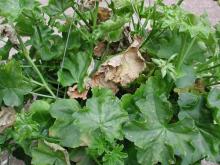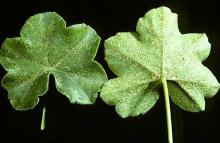See:
Cabbage and Cauliflower (Brassica sp.) - Oedema (Edema)
Cause A physiological problem on many greenhouse plants including geranium. Oedema (edema) is more prominent when air temperatures are lower than soil temperatures, soil moisture is high, and relative humidity is high. Low transpiration rates with an increase in water absorption increase cell pressure, erupting epidermal cells and allowing the inner cells to enlarge and protrude. This protrusion kills the cells and discolors them (yellow, brown, or rust), giving the impression that a parasitic organism is involved. Light levels, low nutrition, and high soil moisture each contribute to oedema development in Pelargonium spp. Ivy geraniums and the cultivar Irene are considered very susceptible. Also affected are Brassica, Dracaena, Fatshedera, Peperomia, and Polyscias. Other plants that can be affected include camellia, eucalyptus, hibiscus, privet, schefflera, and yew.
Few experimental trials on management of edema exist. Consistent root media water content or supplemental calcium applications did not affect the development of edema on ivy geraniums grown in Kansas. Another study indicated that large fluctuations in root media water might contribute to the development of edema. Plant exposed to far-red irradiation did not develop edema.
Symptoms This condition is usually found on lower leaf surfaces. The first symptom is few or numerous watery blisters or galls. Blisters or galls can turn a dark brown-yellow or rust color and look like a rust or bacterial infection. Later the swellings become light brown or tan and corky in texture. Lesions may be concentrated near the leaf margin. They also can be lighter than surrounding areas of the leaf. The entire leaf may yellow and die. Petioles and stems may also show symptoms. Can be confused with mite feeding.
Cultural control
- Do not overwater especially during overcast, cloudy days.
- Use a soilless mix that drains well.
- Do not use saucers on hanging baskets.
- Keep humidity low, by heating if necessary.
- Maintain higher greenhouse temperature.
- Media pH should be around 6 (5.5 for ivy geraniums) and soil temperature at 65°F; check the electrolyte concentration at regular intervals.
- Note that geraniums tend to naturally lower the growing media pH.
Reference Rud, N.A. 2009. Environmental factors influencing the physiological disorders of edema on ivy geranium (Pelargonium peltatum) and intumescences on tomato (Solanum lycopersicum). MS Dissertation, Kansas State University. 99p.



